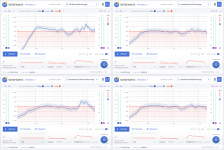Making progress on an eventual balanced drive desktop amp. Under development here is a single ended to balanced drive phase splitter designed by Aksa that provides positive and negative phases to drive two power amp stages in opposition which then powers the headphone. The beauty of this circuit is its simplicity (two transistors) and it operates in SE Class A. It can drive 1.4v (0dBu) into 27ohm loads with only 0.0027% THD - and has headroom to drive 10v p-p if needed. Here is test with actual music you can see opposite phases on oscope.
Does this phase splitter run on the same +18VDC as a PCA?
No, it needs higher Vcc, I use 32v to 35v. It can take as high as 48v (like a Phantom supply for mics).
This may be what I need for my Fostex planars. At 80 mA, how hot does it get?
The case is 35C and the PCB is 73C right where the MOSFETs are, 55C otherwise, and 35C at the batteries. Externally, 35C is not bad - definitely warm though, but man, it drives these HE400i planars very nicely. Gets pretty loud using my Cayin N3 at 90% output. I do not need anymore volume.
The high end on these HE400i's is quite amazing - very detailed and much more resolving than my regular voice coil cans.
My DT880's are out for warranty repair so just have the OB-1's to compare. I would say the OB-1's have more bass.
...The high end on these HE400i's is quite amazing - very detailed and much more resolving than my regular voice coil cans.
My DT880's are out for warranty repair so just have the OB-1's to compare. I would say the OB-1's have more bass.
Hi X first thing is say congratulation those new cans their look is nice into shared picture : )
Other thing is to let you know that looking into free trial of "Sonarworks reference 4" then average response of HE400i looks more a bit like a +9dB resonator thing than real resolving high end stuff doesn't it.
For reference also added DT880 and HD600 plus HD650 (OB-1 is not yet baked into package).
Attachments
Hi Byrtt,
I am out of it, what is Sonarworks? Anyhow, the response indeed is a bit peaky and long term listening is showing this. So without EQ, they can be somewhat fatiguing with pop music and rock. Jazz and classical seem ok still. The HD600/650 look really smooth. My main reason for getting the HE400i was for research rather than listening enjoyment. I do know for sure that my amps can drive them now.
I am out of it, what is Sonarworks? Anyhow, the response indeed is a bit peaky and long term listening is showing this. So without EQ, they can be somewhat fatiguing with pop music and rock. Jazz and classical seem ok still. The HD600/650 look really smooth. My main reason for getting the HE400i was for research rather than listening enjoyment. I do know for sure that my amps can drive them now.
Okay if long term listening changed your HE400i view to be peaky and somewhat fatiguing then that software package probably have it right, info for Sonarworks can be seen here YouTube, in general its a correction package for studio monitors or headphones and it can correct in two ways either via a plugin in ones player or DAW software or it can make a system-wide correction for hole operating system sounds, when up and running with your corrected device it can even simulate another set of headphones or speakers 😛.
I just implemented the above diagram and it works well. I added a CRCRC after the cap Mx and before the amp. It can still play music even when charging via USB as shown in photo below. My charger module has just one connection for the battery and the output. The battery itself has the smart protection circuit built in. I am running at a full 18v Vcc to see how well this can play low impedance phones. I have also retrofitted the new resistor values for low impedance. It turns out adding a parallel 4k7 chip resistor to 1k makes it an 820R so you don't need to uninstall. I did swap out the 270R R5 for 220R though.
...
Here is testing the flat-pack for functionality before putting it in the case:
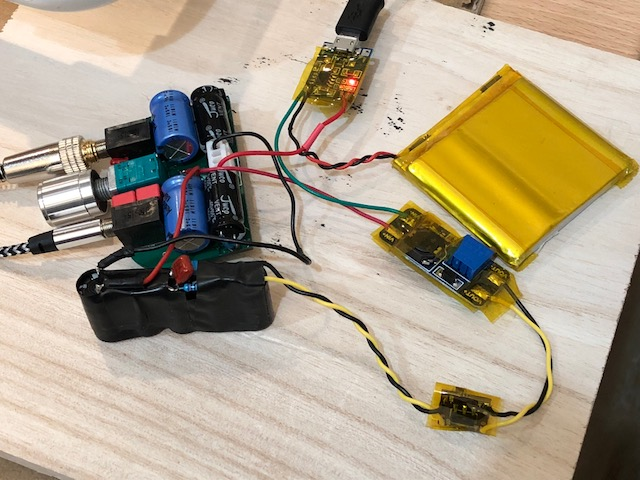
...
The DC step up and CRCRC combo is doing a great job with keeping noise to a minimum level, flat at -130dB.
In the "flat-pack" photo, I'm seeing what looks like 3 red wires spliced together, between the Charger / Battery / PCA - and no splices are shown on the schematic. What's up with that, and does the schematic need to be updated?
Thanks,
David Baldock
My board is slightly different from schematic in that my battery charger / power management board has same set of connections for both battery and load. I also have cap CRCRC filter. So it’s different than Stellar Elephant’s drawing. There’s no wires spliced together: red wires connect power management unit/battery to positive power connector; two red wires from cut traces go to cap multiplier (from switch) and to CRCRC to main positive rail in PCB.
My board is slightly different from schematic in that my battery charger / power management board has same set of connections for both battery and load. I also have cap CRCRC filter. So it’s different than Stellar Elephant’s drawing. There’s no wires spliced together: red wires connect power management unit/battery to positive power connector; two red wires from cut traces go to cap multiplier (from switch) and to CRCRC to main positive rail in PCB.
Thanks!
Can you point to a schematic for the CRCRC filter board that you're using?
No schematic - just wire three 2200uF 16v caps with 0.5w 0.47R resistors on both + and - side as CRCRC.
No schematic - just wire three 2200uF 16v caps with 0.5w 0.47R resistors on both + and - side as CRCRC.
Are the capacitors in parallel, like this?
(the periods are strictly for spacing)
---R---R---
.|.....|....|
.C....C....C
.|.....|....|
---R---R---
Yes. If you have room, another stage even for CRCRCRC.
Are the 16V capacitors connected across the input or output of the voltage booster circuit? If they're on the output, then shouldn't the booster be set below 16V, rather than the 18V of two 9V batteries?
Booster goes to cap multiplier otherwise it shuts down in auto protect when presented with large capacitance - seen as a short. The cap multiplier slowly turns on so booster doesn’t shut down. Cap Mx has 3v drop so set it for 19v output about. Then coming out of so Mx is 16v. You can be a few volts over the rating. Reason I don’t use 25v caps is that they are huge and won’t fit. No caps have been harmed in the process
No, it needs higher Vcc, I use 32v to 35v. It can take as high as 48v (like a Phantom supply for mics).
After the Voltage Booster, do I need to have a CMX and CRCRC feeding the Phase Splitter circuit?
Just trying to figure out how much "support" power supply circuitry (USB Charger (1x), large Li-Po Battery (1x), Voltage Boosters (3x), CMX (2 or 3x), & CRCRC (2 or 3x)) would be needed for a Balanced version of the PCA?
May end up with a Lunchbox sized Power Supply, for an Altoids sized amp... 🙂
If the phase splitter is running a different voltage then it needs its own DC step up and cap Mx and CRC. Not quite lunch box sized as you can see that the parts all fit where the old dual 9v fits. So if you have 3 power supplies it is same volume as 6 x 9v batteries.
I have another solution for you that is simpler. Have you considered building the Aksa Lender preamp as a HPA? It is capable of high rail voltages so you can get the drive level you need with a single ended output amp. I currently have mine setup at 24v rails and it sounds really nice.
Aksa Lender HPA
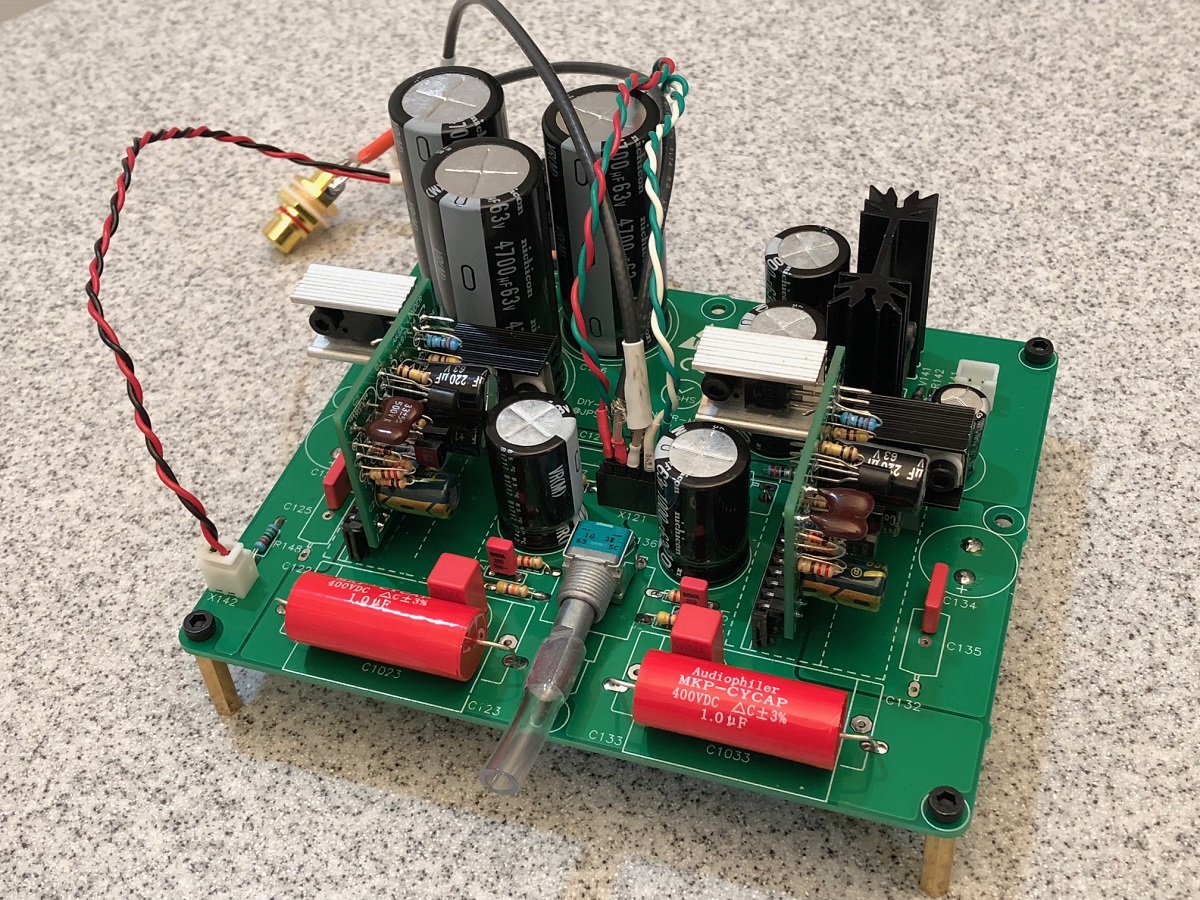
Use these daughterboards where the core amp module resides:
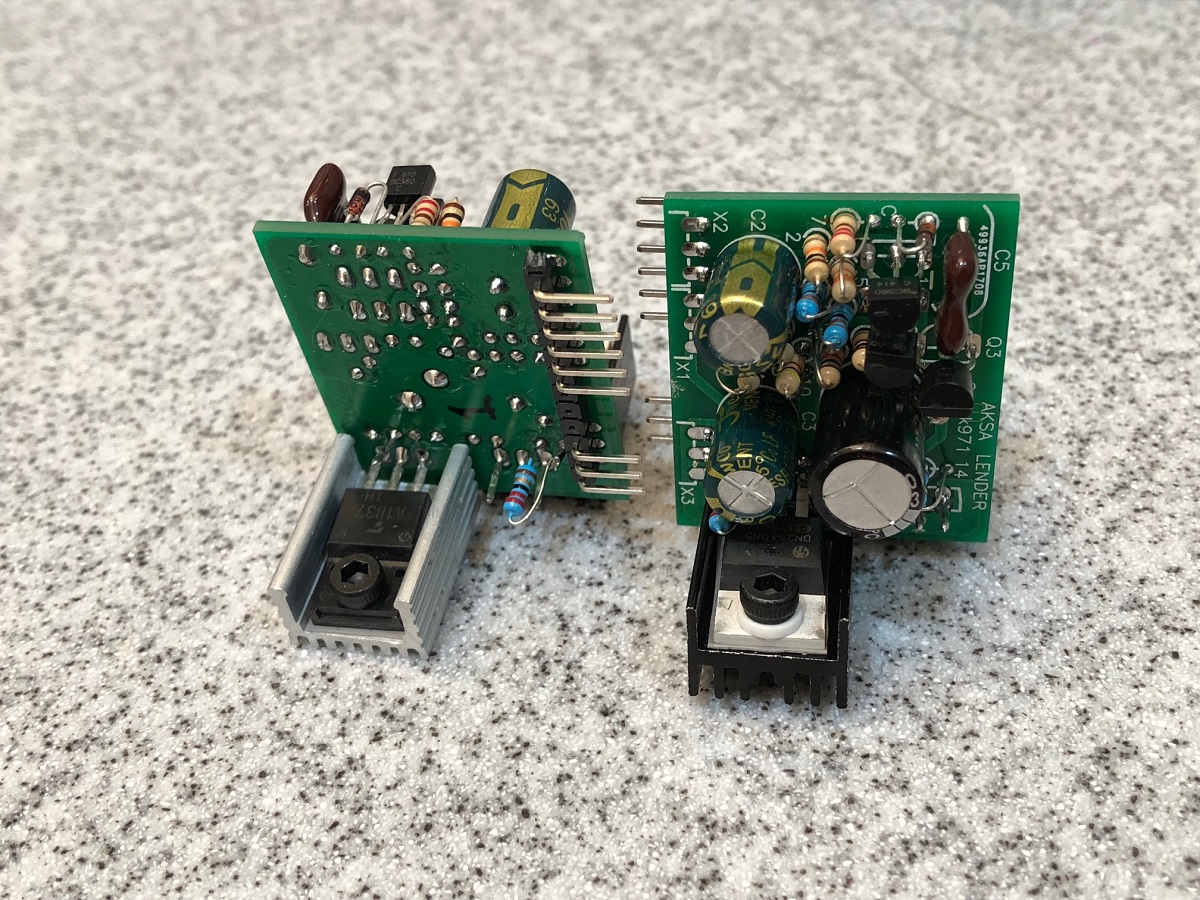
Here is the circuit:
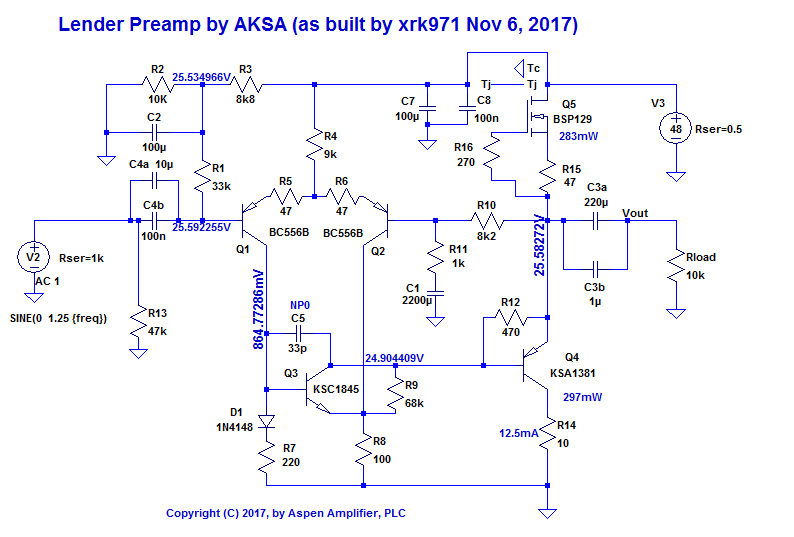
For a HPA, the Vcc goes down to 24v and the KSA1381 is replaced with a Tosiba 2SA1837, and BSP129 is replaced with DN2540, plus a few resistor changes:
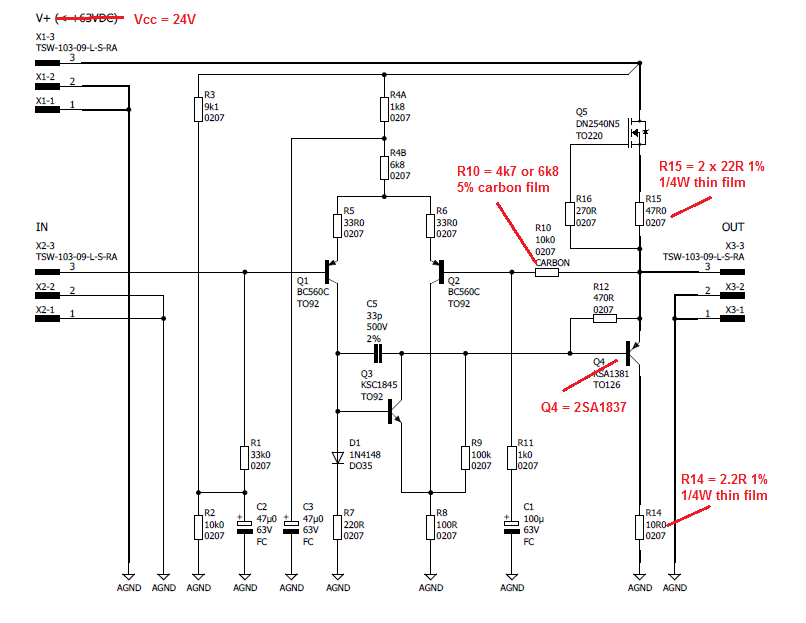
Here is 2.0Vpp into 43ohms:
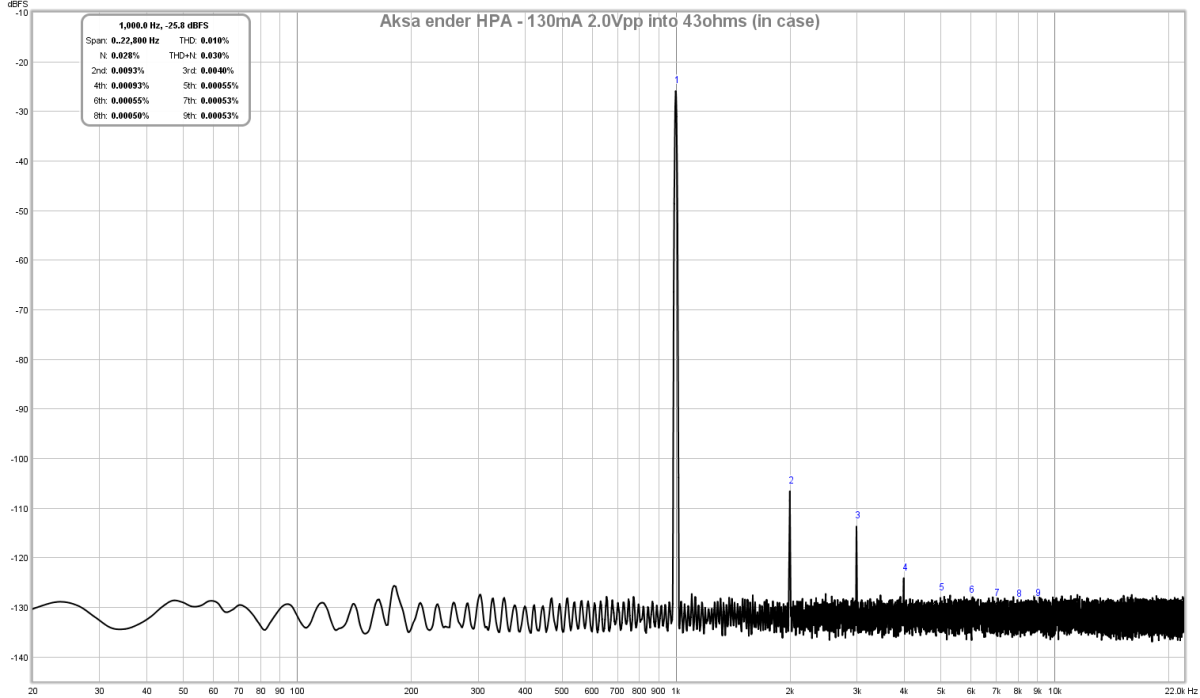
Anyhow, a GB is underway and you could just build this as a desktop amp.
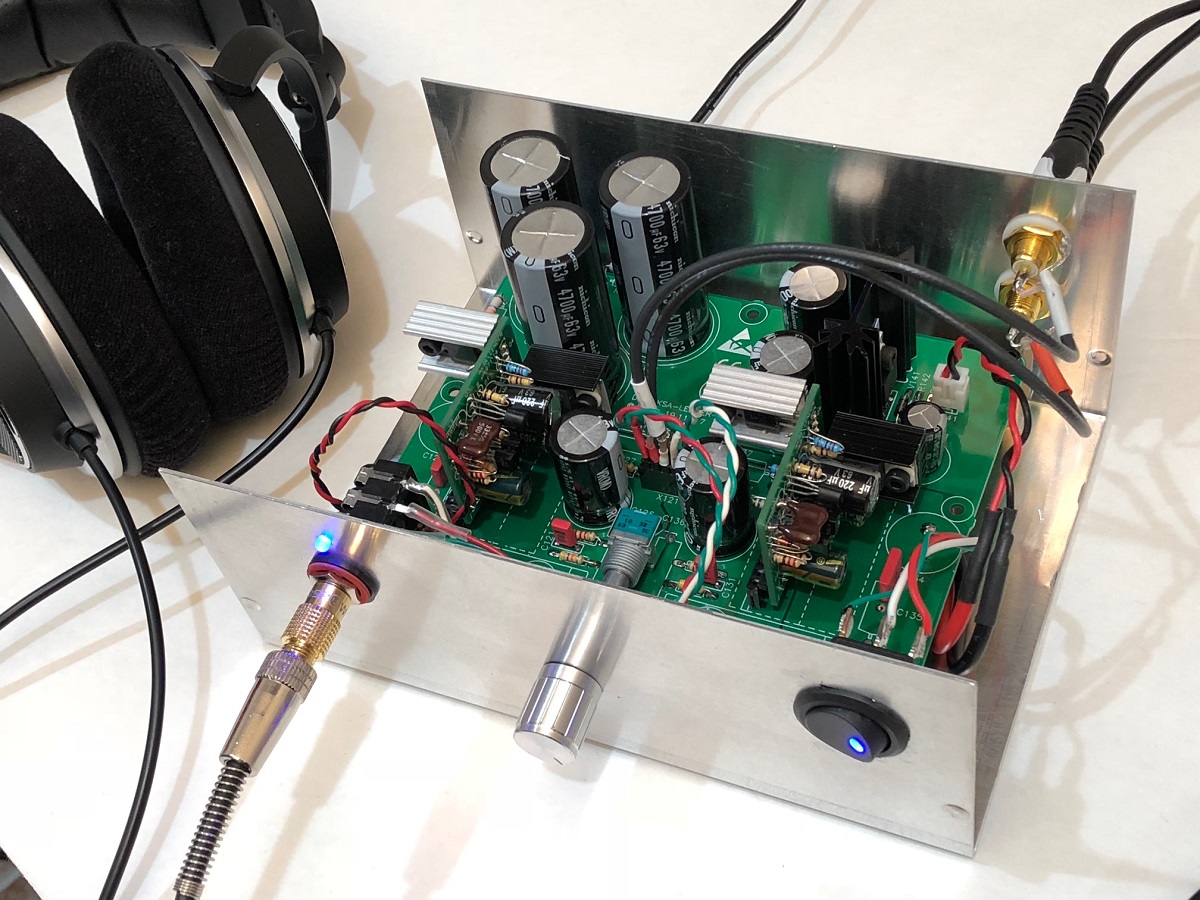
You could use a really nice case like Vunce did:
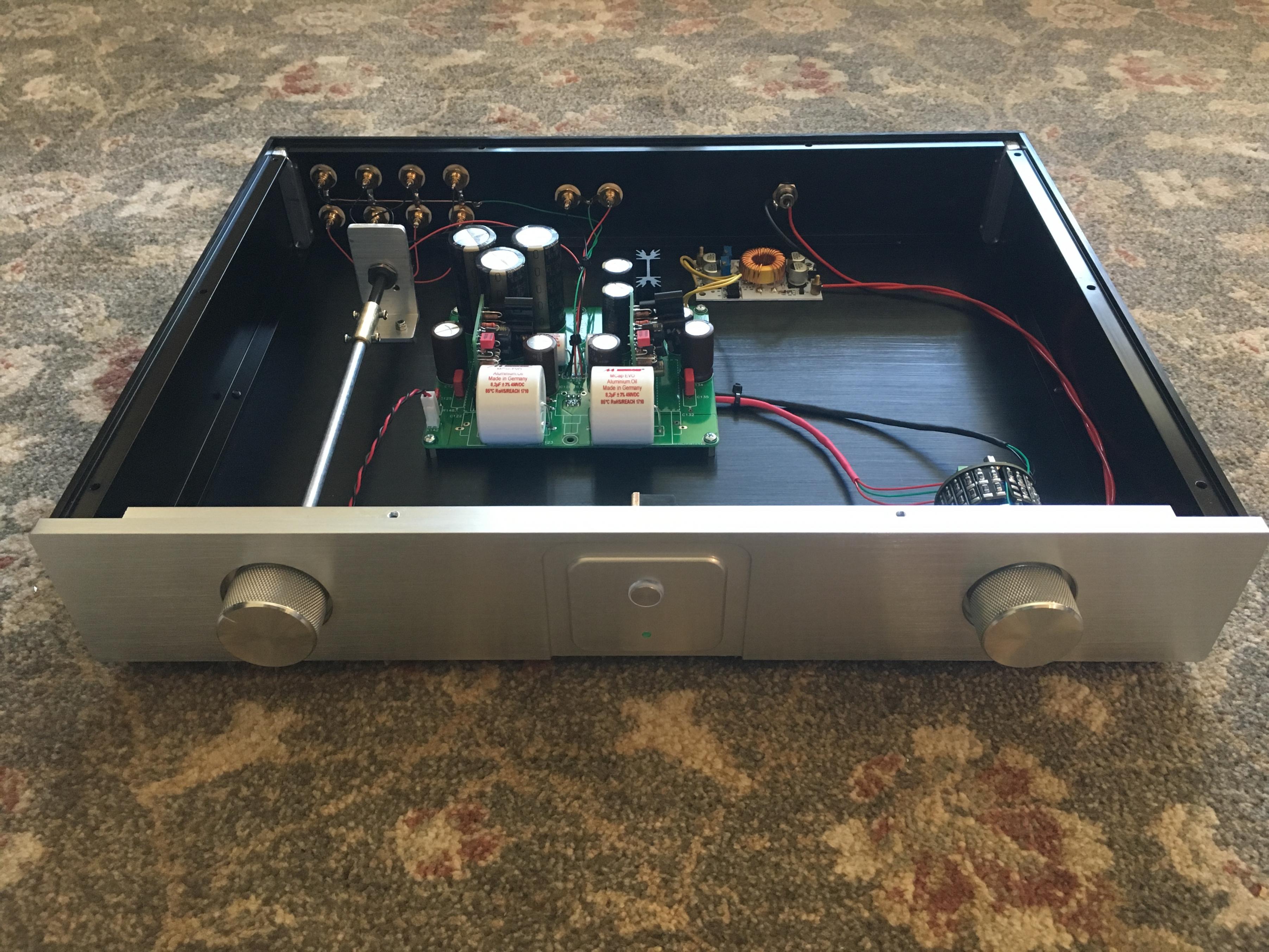
I suspect if you made this amp, it would really outperform two PCA's in balanced drive mode even.
I have another solution for you that is simpler. Have you considered building the Aksa Lender preamp as a HPA? It is capable of high rail voltages so you can get the drive level you need with a single ended output amp. I currently have mine setup at 24v rails and it sounds really nice.
Aksa Lender HPA
Use these daughterboards where the core amp module resides:
Here is the circuit:
For a HPA, the Vcc goes down to 24v and the KSA1381 is replaced with a Tosiba 2SA1837, and BSP129 is replaced with DN2540, plus a few resistor changes:
Here is 2.0Vpp into 43ohms:
Anyhow, a GB is underway and you could just build this as a desktop amp.
You could use a really nice case like Vunce did:
I suspect if you made this amp, it would really outperform two PCA's in balanced drive mode even.
Status update on LiPo powered system...
So in daily commuter bus use for almost a month now and I have to say this is working out really well. I get to work and I charge it on my desk. When it plays, voltage is regulated so distortion level is constant. It runs pretty warm which has been handy as a hand warmer on the cold walks from bus stop to my office. System is very reliable.
Perhaps a combo PSU board with LiPo JST jack, DC step up, cap Mx, CRCRC would be useful?
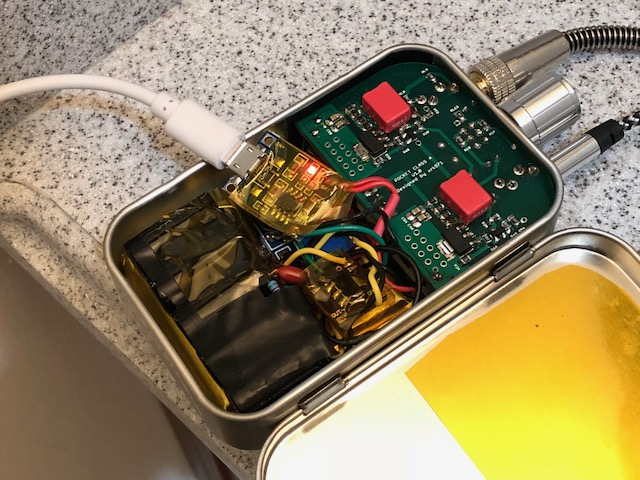
So in daily commuter bus use for almost a month now and I have to say this is working out really well. I get to work and I charge it on my desk. When it plays, voltage is regulated so distortion level is constant. It runs pretty warm which has been handy as a hand warmer on the cold walks from bus stop to my office. System is very reliable.
Perhaps a combo PSU board with LiPo JST jack, DC step up, cap Mx, CRCRC would be useful?
I appreciate the suggestion, but I'd like to try the simplest audio circuit at least once (2 transistors in each of two phase splitters, 4 transistors in each channel of the Balanced output Amp - for a total of 12 active devices in the audio path).
Does every single audio stage need it's own completely separate power supply section, after the Battery & Charger? (i.e.- one Voltage Booster, CMX, & CRCRC for each phase splitter and PCA)
Does every single audio stage need it's own completely separate power supply section, after the Battery & Charger? (i.e.- one Voltage Booster, CMX, & CRCRC for each phase splitter and PCA)
Because the system is capacitively-coupled, a single DC supply battery can be used on all You would need two DC step ups. One to make 16v after cap Mx for amp at high current (300mA for 4 amp cores at 75mA ea), and another to make 32v for phase splitter at low current (circa 40mA for qnty 2 phase splitters). Each needs its own cap Mx and CRCRC. The left and right can have two separate CRCRC's (for better stereo separation) but share same Cap Mx.
where was this low Z mod detailed? went back a few pages but didn't see anything. Are those resistors the only thing that changes?
I just built a new amp with special NHB low impedance option. With revised resistor network described earlier (R3=820R, R4=33R, R5=220R) and hot running FETs to get 80mA bias current. So the ultimate test are 32 ohm 93dB orthodynamic planars. I just got myself a set of HE400i’s and am happy to say that they are working very well together. No bass dropout or bass distortion on heavy drum beats, and very articulate highs. Reminds me of an AMT.

- Home
- Group Buys
- xrk971 Pocket Class A Headamp GB
